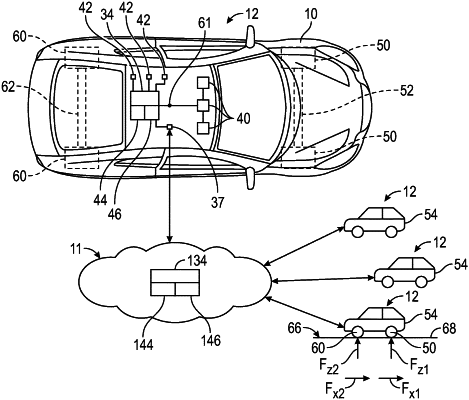| CPC B60W 60/0015 (2020.02) [B60W 50/0097 (2013.01); G05B 13/027 (2013.01); B60W 2050/0022 (2013.01); B60W 2520/14 (2013.01); B60W 2530/10 (2013.01); B60W 2530/20 (2013.01)] | 19 Claims |

|
1. A method for vehicle motion control, comprising:
aggregating vehicle state data from a host vehicle and a plurality of remote vehicles, wherein the vehicle state data comprises a vehicle state for each of the host vehicle and the plurality of remote vehicles, the vehicle state including velocity, position, heading, and acceleration;
normalizing the aggregated vehicle state data by chassis categories, vehicle model, and vehicle usage category for each of the host vehicle and plurality of remote vehicles;
determining a road surface condition data using sensor data from each of the host vehicle and the plurality of remote vehicles, wherein the road surface condition is a coefficient of friction between tires and a surface of a road where the host vehicle and the plurality of remote vehicles are driving;
determining an actuation command data for each of the host vehicle and the plurality of remote vehicles;
associating the vehicle state data with the road surface condition data and the actuation command data to define driving scenarios;
determining a forward dynamics for each of the host vehicle and the plurality of remote vehicles for each of the driving scenarios based on the vehicle state data, the road surface condition data, and the actuation command data, wherein the forward dynamics include the magnitude and direction of the normal forces under front tires and rear tires as well as the traction forces of the front tires and the rear tires while the host vehicle and the plurality of remote vehicles moves forward;
training a recurrent neural network using the forward dynamics for each of the host vehicle and the plurality of remote vehicles using a supervised learning method,
determining, using the recurrent neural network trained on the forward dynamics, predicted vehicle states for the host vehicle in the driving scenarios;
inputting the predicted vehicle states and the road surface condition data into the recurrent neural network to predict actuation commands for the driving scenarios; and
commanding the host vehicle to move autonomously in accordance with a trajectory that uses the actuation commands determined using the recurrent neural network.
|